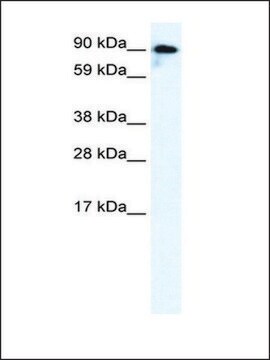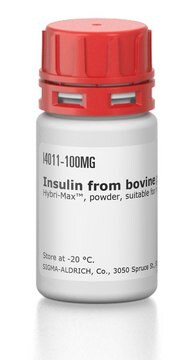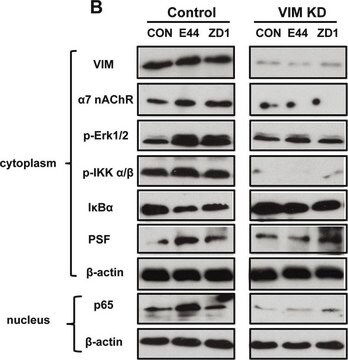MABF1032
Anti-NKG2D (CD314) Antibody, clone 1D11
clone 1D11, from mouse
别名:
NKG2-D type II integral membrane protein, Killer cell lectin-like receptor subfamily K member 1, NK cell receptor D, NKG2-D-activating NK receptor, CD314
登录查看公司和协议定价
所有图片(2)
About This Item
分類程式碼代碼:
12352203
eCl@ss:
32160702
NACRES:
NA.41
推荐产品
生物源
mouse
品質等級
抗體表格
purified immunoglobulin
抗體產品種類
primary antibodies
無性繁殖
1D11, monoclonal
物種活性
human
包裝
antibody small pack of 25 μL
技術
flow cytometry: suitable
immunohistochemistry: suitable
immunoprecipitation (IP): suitable
同型
IgG1κ
NCBI登錄號
UniProt登錄號
運輸包裝
ambient
目標翻譯後修改
unmodified
基因資訊
human ... KLRK1(22914)
一般說明
NKG2-D type II integral membrane protein (UniProt: P26718; also known as Killer cell lectin-like receptor subfamily K member 1, NK cell receptor D, NKG2-D-activating NK receptor, CD314) is encoded by the KLRK1 (also known as D12S2489E, NKG2D) gene (Gene ID: 100528032) in human. NK cell receptor D is a homodimeric, disulfide-linked, single-pass type II membrane protein that can also form heterohexamers along with four subunits of HCST/DAP10. NK cell receptor D contains a cytoplasmic domain (aa 1-51), a transmembrane helical domain (aa 52-72), and an extracellular domain (aa 73-216). It functions as an activating and co-stimulatory receptor involved in immunosurveillance upon binding to various cellular stress-inducible ligands displayed at the surface of autologous tumor cells and virus-infected cells. It provides both stimulatory and co-stimulatory innate immune responses on activated killer (NK) cells, leading to their cytotoxic activity. Also acts as a co-stimulatory receptor for T-cell receptor (TCR) in CD8+ T-cell-mediated adaptive immune responses by amplifying T-cell activation. NK cell receptor D is expressed in natural killer (NK) cells, CD8+ alpha-beta and gamma-delta T-cells. Its expression in NK cells is upregulated by interleukin 15 (IL15).
特異性
Clone 1D11 detects NKG2-D type II integral membrane protein in human cells.
免疫原
Whole NKL cells (aggressive cell line derived from human natural killer cell leukemia).
應用
Anti-NKG2D (CD314), clone 1D11, Cat. No. MABF1032, is a mouse monoclonal antibody that detects human NKG2-D type II integral membrane protein and has been tested for use in Flow Cytometry, Fluorescence Activated Cell Sorting (FACS), Immunohistochemistry, Immunoprecipitation, ECM Adhesion and Inhibit
Fluorescence Activated Cell Sorting (FACS): A representative lot detected NKG2D (CD314) in Fluorescence Activated Cell Sorting applications (Groh, V., et. al. (2003). Proc Natl Acad Sci U S A. 100(16):9452-7).
Flow Cytometry Analysis: A 1:500 dilution from a representative lot detected NKG2D (CD314) in CD3-/CD56+ T cells (Courtesy of Alejandro Lopez-Soto, Ph.D., Tumor Immunology Group, Universidad de Oviedo, IUOPA Spain).
Inhibits Activity/Function: A representative lot of Anti-NKG2D (CD314), clone 1D11, reduced the percentage of degranulating NK cells in freshly isolated PBMCs when co-incubated with K562 cells (Courtesy of Alejandro Lopez-Soto, Ph.D., Tumor Immunology Group, Universidad de Oviedo, IUOPA Spain).
Immunohistochemistry Analysis: A representative lot detected NKG2D (CD314) in Immunohistochemistry applications (Groh, V., et. al. (2003). Proc Natl Acad Sci U S A. 100(16):9452-7).
Inhibition Analysis: A representative lot inhibited NKG2D activated cytolytic responses of gamma delta T cells and NK cells against transfectants and epithelial tumor cells expressing MICA. (Bauer, S., et. al. (1999). Science. 285(5428):727-9).
Stimulates ECM Adhesion: A representative lot of Anti-NKG2D (CD314), clone 1D11 stimulated ECM Adhesion (Abeyweera, T.P., et. al. (2011). J Cell Biol. 192(4):675-90).
Flow Cytometry Analysis: A representative lot detected NKG2D (CD314) in Flow Cytometry applications (Wu, J., et. al. (2002). J Immunol. 169(3):1236-40; Bauer, S., et. al. (1999). Science. 285(5428):727-9; Wu, J., et. al. (1999). Science. 285(5428):730-2; Roberts, A.I., et. al. (2001). J Immunol. 167(10):5527-30).
Immunoprecipitation Analysis: A representative lot detected NKG2D (CD314) in Immunoprecipitation applications (Bauer, S., et. al. (1999). Science. 285(5428):727-9).
Flow Cytometry Analysis: A 1:500 dilution from a representative lot detected NKG2D (CD314) in CD3-/CD56+ T cells (Courtesy of Alejandro Lopez-Soto, Ph.D., Tumor Immunology Group, Universidad de Oviedo, IUOPA Spain).
Inhibits Activity/Function: A representative lot of Anti-NKG2D (CD314), clone 1D11, reduced the percentage of degranulating NK cells in freshly isolated PBMCs when co-incubated with K562 cells (Courtesy of Alejandro Lopez-Soto, Ph.D., Tumor Immunology Group, Universidad de Oviedo, IUOPA Spain).
Immunohistochemistry Analysis: A representative lot detected NKG2D (CD314) in Immunohistochemistry applications (Groh, V., et. al. (2003). Proc Natl Acad Sci U S A. 100(16):9452-7).
Inhibition Analysis: A representative lot inhibited NKG2D activated cytolytic responses of gamma delta T cells and NK cells against transfectants and epithelial tumor cells expressing MICA. (Bauer, S., et. al. (1999). Science. 285(5428):727-9).
Stimulates ECM Adhesion: A representative lot of Anti-NKG2D (CD314), clone 1D11 stimulated ECM Adhesion (Abeyweera, T.P., et. al. (2011). J Cell Biol. 192(4):675-90).
Flow Cytometry Analysis: A representative lot detected NKG2D (CD314) in Flow Cytometry applications (Wu, J., et. al. (2002). J Immunol. 169(3):1236-40; Bauer, S., et. al. (1999). Science. 285(5428):727-9; Wu, J., et. al. (1999). Science. 285(5428):730-2; Roberts, A.I., et. al. (2001). J Immunol. 167(10):5527-30).
Immunoprecipitation Analysis: A representative lot detected NKG2D (CD314) in Immunoprecipitation applications (Bauer, S., et. al. (1999). Science. 285(5428):727-9).
品質
Isotype testing: Identity Confirmation by Isotyping Test.
Isotyping Analysis: The identity of this monoclonal antibody is confirmed by isotyping test to be mouse IgG1 .
Isotyping Analysis: The identity of this monoclonal antibody is confirmed by isotyping test to be mouse IgG1 .
標靶描述
25.27 kDa calculated.
外觀
Format: Purified
其他說明
Concentration: Please refer to lot specific datasheet.
未找到合适的产品?
试试我们的产品选型工具.
儲存類別代碼
12 - Non Combustible Liquids
水污染物質分類(WGK)
WGK 1
閃點(°F)
Not applicable
閃點(°C)
Not applicable
我们的科学家团队拥有各种研究领域经验,包括生命科学、材料科学、化学合成、色谱、分析及许多其他领域.
联系技术服务部门




